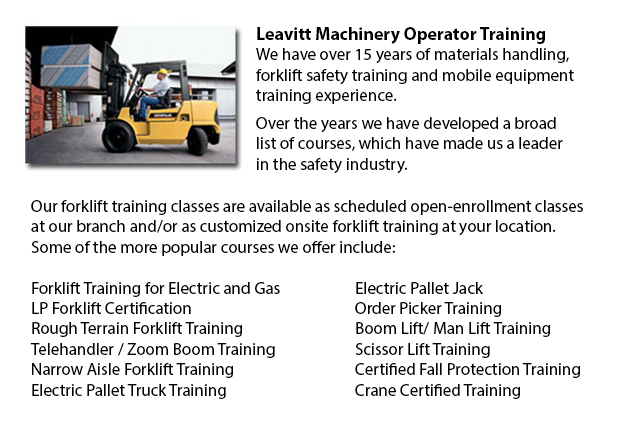
Pallet Stackers Training Ottawa - A pallet stacker is a kind of pallet jack that is utilized to transfer, stack and lift palletized goods that are overly arduous for manual lifting. Its main function is to load and unload pallets on trucks, in addition to transferring pallets to and from a variety of locations within a storage space or warehouse. On the whole pallet jacks are built of heavy duty materials to endure extreme weights. Pallet stackers are often referred to as pallet jacks. They can be operated from a seated, upright or walk-behind position. Pallet stackers are divided into manual and powered types.
Certain basic parts comprise the pallet jack. There are forks that slide underneath a pallet, capable of moving and raising it to a desired height. The motor compartment or casing houses the gas-run, electronic or hydraulic equipment that powers the appliance.
Typically, pallet jacks come in walk-behind models that are hand-powered. This means that they are moved by pushing and pulling the jack into its desired location, while raising the heavy pallets can be operated hydraulically making this task a good deal easier. Using a foot pedal or handle raises the stacker's forks. Squeezing a handle or trigger returns the forks to the ground. These models of pallet stackers are perfect for lighter loads of up to approximately 1 ton or 907.18 kg.
Most jacks can accommodate the raising of extreme weights to around 5 tons with either the gas or electric versions. They are physically less demanding to control than the labor-intensive models thanks to the hydraulic power that hoists and lowers the forks. These styles are steered by turning the handle in a specific direction. There is a button on the knob that operates to raise and lower the forks. A throttle set up on the stacker's handle moves the machine forward and in reverse. This style of equipment is generally known as a lift truck and is used from a sit-down posture.
As the fork width, weight limit and lift height vary dramatically between individual styles, picking the right pallet jack to suit the activity is critical. Some stacker's lift peak may allow several pallets to be stacked, while others may only allow two at a time. Some types of these hoists include an changeable fork so as to permit the jack to slide underneath pallets of different sizes and shapes. Numerous fork models might be fairly successful when different types of pallets are being utilized in the same stockroom.
-
Hyster Forklift
Hyster Forklift Training Ottawa - Hyster is presently a world leader in lift trucks and warehousing solutions. However, it began as a producer of lifting machines as well as winches. Most of its production was concentrated in the northwest United S... More -
Rough Terrain Forklifts
Rough Terrain Forklifts Training Ottawa - There are actually two distinctive categories of forklifts within the material handling market, the industrial model and the rough terrain model. Rough terrain lift trucks first came on the market in the 1940... More -
Scissor Lifts
Scissor Lift Training Ottawa - The scissor lift or platform lift, is a mechanized industrial lift that may be tailored to be used in retail, wholesale, manufacturing and production environments. Industrialized scissor lifts have been used chiefly wit... More -
Komatsu Forklift
Komatsu Forklift Training Ottawa - Komatsu Forklift U.S.A. Inc. has a very good reputation for building reliable and resilient forklifts. Komatsu is acknowledged around the world as a business with a rich heritage while preserving an outstanding benc... More -
Nissan Forklift
Nissan Forklift Training Ottawa - Nissan Motor Co. Ltd prides itself on attaining complete customer fulfillment when enjoying one of their car, truck or forklift products. They are fully committed to providing high value and detail-oriented quality v... More

Forklift Certification Ottawa
TOLL FREE: 1-888-254-6157
Ottawa, Ontario
forkliftcertificationottawa.com
Email Us
About Us


